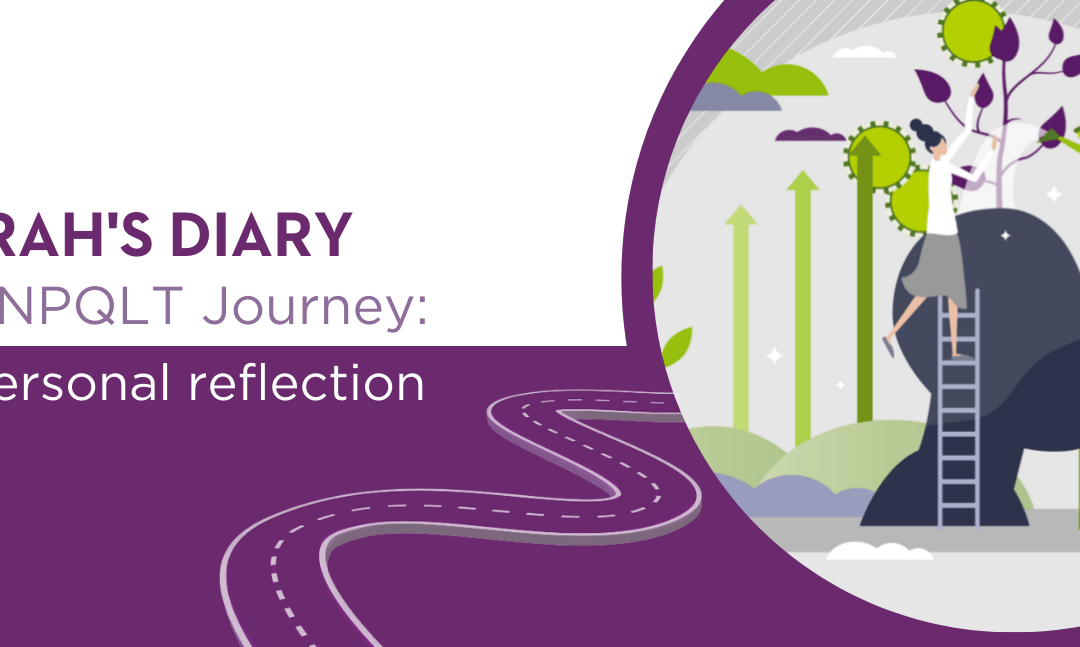Sarah Dunsby, Head of Geography at Bushey Meads School, embarked on her TDT NPQLT this autumn with our delivery partner Shared Learning Trust. Here, she shares with us her diary recording her experiences and reflections so far; and how the TDT NPQLT curriculum and delivery model is helping her achieve her goals.
My Journey
“When I applied for the National Professional Qualification in Leading Teaching I was looking forward to learning how to manage a small team as part of my new role as Head of Geography. I was, however, a little anxious about time management – about having the time needed to complete my studies – and concerned that all the content may go over my head. As it turns out, my worries were soon put to rest. The curriculum and delivery model clearly set out the path for my learning journey, and with the resources supplied and the support and guidance from my NPQLT facilitator I was soon on my way.
I recorded the impact and reflections of my learning in a diary and share these with you below.
The first term’s theme was around Leading Professional Learning, which focused on two key chapters: Implementation and School Culture

IMPLEMENTATION, Module A – Learning that…
Here we were introduced to the big ideas around implementation and how to successfully implement change. This was delivered in two parts. Unit 1: focused on the process of change, Unit 2 focused on implementing improvement.
- I found I made the time to complete the work as it was interesting and has already started to feed into my management approach.
- The concept of treating implementation as a process was highlighted throughout and the idea that 75% of the time implementing an idea should come from the explore and prepare process.
- The quote from Williams and Thompson 2008 has had the most impact. It discusses the separateness of every classroom and no matter how much you scaffold and plan, every teacher has to get it and do it right, as it is impossible to track what every teacher is doing in their own classroom. This has really helped when it comes to planning SoL as it has shown that a one size fits all approach doesn’t work and to have effective lessons we need to work together on planning SoL
- It has also made me evaluate the need to reduce workload if you are implementing a new project, what needs to be taken away so all staff understand the new project or new lessons. In terms of being in a geography department this could be using departmental time more effectively to run training on the new SoL or projects.
Local Webinar 1
Following the completion of Module A the participants attended a local webinar, where we were able to meet and discuss what we had learnt. It was nice to learn that other people had similar takeaways and it made me feel I was doing things correctly. A very positive aspect was being able to chat to people in breakout rooms on Zoom and see their experiences – as a secondary school teacher I rarely talk to primary school teachers so the breakout rooms were a really nice touch.
Module B – Learning How to…
Here we applied our learning from module A.
- Very busy half term but I still found I made time for my weekly NPQ session.
- The content was broken up into 10-20 minutes sections and was really manageable with my already very hectic workload as a HoD.
- The content was interesting and helped develop the knowledge from the previous topic.
- I do carry round my NPQLT notebook in every bag just in case I find time in the day to do a quick module.
- The use of examples in a school setting has made the learning from the previous sections come to life.
SCHOOL CULTURE, Module A – Learning that…
This chapter explored the big ideas around culture and how this impacts on a school’s ability to thrive. The first unit of this chapter was around a culture of high expectations.
- At the moment schools are experiencing many challenges such as: Covid, staff shortages, student development, staff wellbeing, uncertainty regarding exams, student behaviour, and teacher expectations.
- This chapter was incredibly eye opening and the timing of it with all of the factors rang true.
- I spent a lot of time taking pictures of sentences from the text and sending it to my friends from work with ‘wishful thinking’.
- However, it has made me much more aware of school culture and the concept that if staff are happy then students are happy, and therefore the learning environment improves.
- The case studies were particularly useful as they mentioned multiple people and gave a mixture of KS1-KS5 examples, which opened up the concepts to all teachers on the course.
I am now embarking on the second Unit of this chapter focusing on the culture of professional learning and look forward to being able to update you soon…”
Their Journey. Your Journey.
If you have enjoyed reading about Sarah’s experiences of the TDT NPQLT you can follow her journey, and that of other NPQ participants, by subscribing to our Your Journey – NPQs with TDT newsletter.

